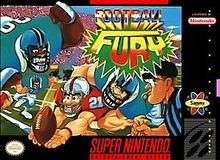Football Fury
Football Fury (ウルティメイト フットボール, lit. "Ultimate Football")[4] is a Super NES video game that was released in 1992. The game's full Japanese name is Ultimate Football: Try Formation!.
| Football Fury | |
|---|---|
 North American cover art | |
| Developer(s) | Aicom (merged into Sammy Studios)[1] |
| Publisher(s) | |
| Composer(s) | Megumi Maz-ura[3] |
| Platform(s) | Super NES |
| Release | |
| Genre(s) | Traditional football simulation[2] |
| Mode(s) | Single-player Multiplayer (up to two players) |
Summary
The actual gameplay takes place in a playoffs system of a fictional American football league.[5] Gameplay involves the usual football fare of choosing a play and attempting to execute it.[5] On offense, when throwing the football, a meter appears which measures the strength of the passer's throw.[5] On defense, the player controls a defensive player and tries to tackle the opposing ball carrier or attempt to break up a pass play.[5] There is an option to either play with or without background music.[5]
There are two conferences: the United States Football Conference (USFC) and the American All-Star Football Conference (AAFC). Even though the teams are fictional, they use the cities of the actual NFL teams of the early 1990s.[5] Passwords allow saved games to be restored while a news report is made after each game through the fictional cable television network ZIFN.
| Reception | ||||||
|---|---|---|---|---|---|---|
| ||||||
References
- GDRI [@gdri] (8 April 2014). "Football Fury was developed not by Aicom (GameFAQS, Wikipedia), but at Sammy after Aicom was merged into it" (Tweet) – via Twitter.
- "Release information". GameFAQs. Retrieved 2011-05-24.
- "Composer information". SNES Music. Retrieved 2012-03-29.
- "English-Japanese title translation". SuperFamicom.org. Retrieved 2011-05-24.
- "Basic game overview". MobyGames. Retrieved 2011-05-30.